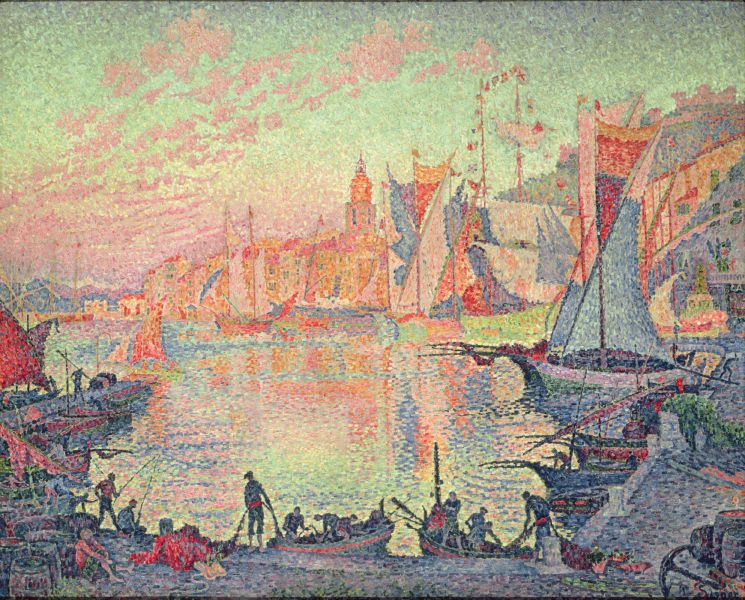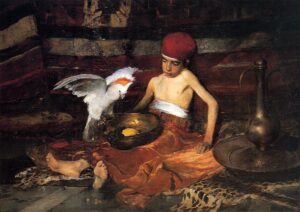Paintings of Saint-Tropez: Colour, boats and bathers 2

This weekend we’re seeking refuge from the winter in Saint-Tropez on the Côte d’Azur, in the company of some of the artists who painted its warm light. By 1897 it had good connections by express trains to Paris, and Paul Signac had just bought a house in the old port and moved there with his wife. Although Théo van Rysselberghe didn’t move to the coast until he retired in 1911, he was a frequent visitor.
Their friend Maximilien Luce had first visited Saint-Tropez in 1892 with Signac, and continued to travel south despite remaining based in Paris until his death there in 1941.
Maximilien Luce (1858–1941), Saint-Tropez (1897), colour lithograph, 25.8 x 39.1 cm, Cleveland Museum of Art, Cleveland, OH. Wikimedia Commons.
Luce became skilled in colour lithography. His finest print is this of Saint-Tropez from 1897. Here he substitutes dashes of colour for the small dots of Pointillist painting, with the aim of getting adjacent colours to interact and generate a glow of colour. This is taken from Divisionist theory as first developed by Seurat, then later by Signac.
Paul Signac (1863-1935), Saint-Tropez. Route de la Foux (Golfe Juan) (Cachin 314) (1897), oil on canvas, 65.4 x 81.3 cm, Worcester Art Museum, Worcester, MA. Wikimedia Commons.
That year, Paul Signac painted this unusual view of Saint-Tropez. Route de la Foux, also known as Golfe Juan, (1897). This looks back at Saint-Tropez from the main road running west towards Port Cogolin at the end of the Gulf of Saint-Tropez. Visible to the left is Saint-Tropez lighthouse, and its bell tower in the centre.
Paul Signac (1863-1935), Saint-Tropez. La Terrasse (Cachin 320) (1898), oil on canvas, 72.5 x 91.5 cm, National Gallery of Ireland, Dublin, Ireland. Image by Sailko, via Wikimedia Commons.
Signac started painting Saint-Tropez. The Terrace on 16 August 1898, aiming to complete it about ten days later. It shows his wife Berthe on the Italianate terrace that they had built at their house La Hune. It looks north, over vineyards and the old town of Saint-Tropez with its distinctive bell tower, the small bay beyond, to the Maures hills in the distance. The artist envisaged the lone figure being a young woman in the sunset of her life as one of the many victims of tuberculosis.
Paul Signac (1863–1935), Saint-Tropez (Cachin 359) (1901-02), oil on canvas, 131 x 161.5 cm, National Museum of Western Art, Tokyo. WikiArt.
Although Signac started work on this view of the port of Saint-Tropez in 1901, he didn’t complete it until early the following year. At its centre is the bell tower, and the citadel looks down from its upper right. Its Tartane sailing vessels are being loaded with their cargo of barrels. Although its Divisionist technique and colours are thoroughly contemporary, it harks back to a tradition of port views by Claude Lorrain and Joseph Vernet.
Paul Signac (1863-1935), The Harbour Entrance, St.Tropez (c 1902), media and dimensions not known, Private collection. Wikimedia Commons.
The Harbour Entrance, Saint-Tropez from about 1902 appears to be one of Signac’s oil sketches with some colour tiling in the water.
Paul Signac (1863-1935), Saint-Tropez, Tartanes in the Port (1905), further details not known. Wikimedia Commons.
Saint-Tropez, Tartanes in the Port from 1905 is one of the many watercolours Signac painted of these distinctive Tartanes in the harbour of Saint-Tropez, with its prominent lighthouse in the background.
Maximilien Luce (1858–1941), Bathers at Saint-Tropez (c 1909), oil on canvas, 110 x 150.1 cm, location not known. Wikimedia Commons.
Maximilien Luce continued to visit the Mediterranean coast of France, where he painted these Bathers at Saint-Tropez in about 1909. His colours are considerably less brash and dazzling than other former Neo-Impressionists like Théo van Rysselberghe.
Paul Signac (1863-1935), Saint-Tropez, Boat being Careened (1920), further details not known. Image by Finoskov, via Wikimedia Commons.
Signac’s Saint-Tropez, Boat being Careened from 1920 is an unusual watercolour of a boat that has been deliberately grounded alongside the quay, to allow maintenance to be performed on its hull. As a longstanding yachtsman he had considerable insight into this procedure.
Pierre Bonnard (1867-1947), The Port of Saint-Tropez (c 1921), oil on canvas, 65.4 x 81.3 cm, Private collection. The Athenaeum.
Pierre Bonnard began to visit the Côte d’Azur long before he started moving to Le Cannet in 1924, and went sailing in the Mediterranean with Paul Signac. Bonnard painted this view of an almost deserted Port of Saint-Tropez on a breezy day, with small wavelets forming on the water surface. The mole at the right ends in a lighthouse, which merges visually with the sailing ship’s superstructure.
Paul Signac (1863-1935), Saint-Tropez, the Pier (21 December 1923), black pen and watercolour on paper, 21 x 19 cm, location not known. Wikimedia Commons.
Paul Signac painted this view of boats at low tide alongside Saint-Tropez, the Pier on 21 December 1923. Even with Spring tides, the tidal range at Saint-Tropez is little more than 30 cm (1 foot), suggesting these boats have been deliberately beached alongside the pier.
During the 1920s Saint-Tropez became the most fashionable resort in Europe when it drew Coco Chanel and a host of other celebrities. Later in the twentieth century it attained fame again as a ‘topless’ beach resort despite its mayor ordering its police helicopter to check that sunbathers were correctly dressed, and ‘clothing fights’ broke out with the police. I hope you have enjoyed this weekend, whatever you were not wearing in Saint-Tropez.




